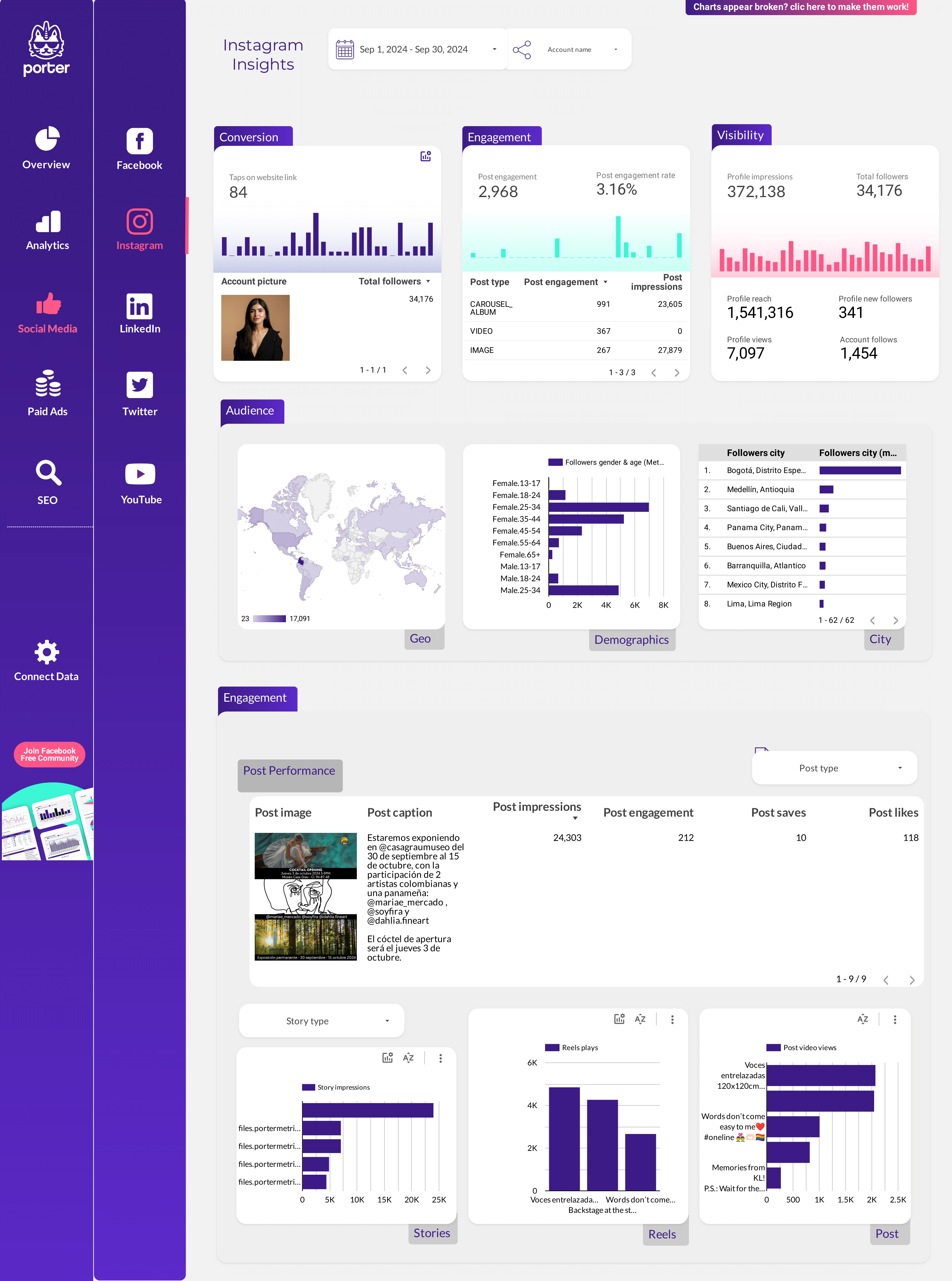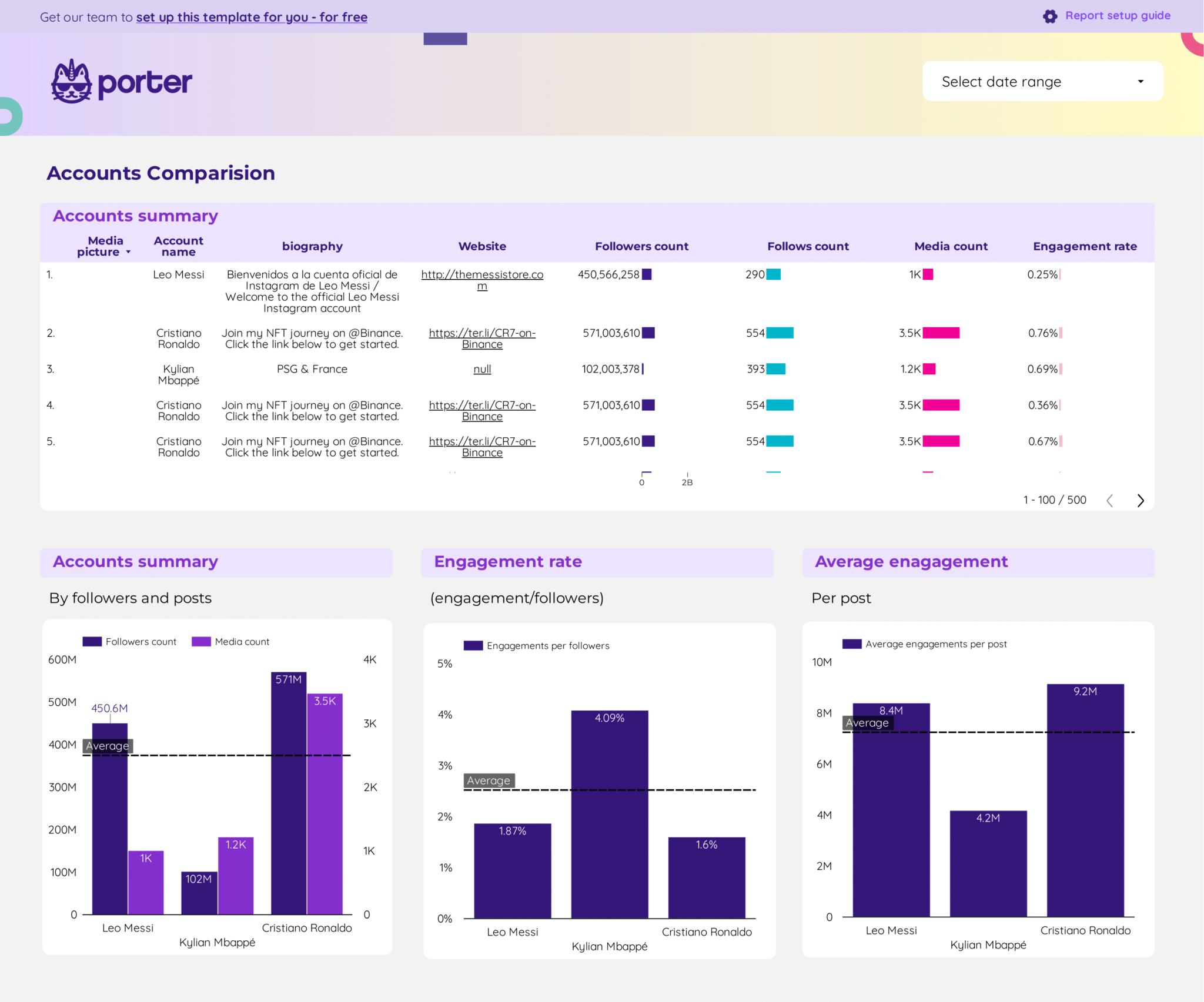
Social Media competitors Dashboard template
Introducing the Social Media Competitors Dashboard Template, a powerful tool designed for analyzing and comparing public data across multiple social media platforms. This template provides insights into your competitors’ performance on platforms such as Instagram, Facebook, LinkedIn, Google Business Profile, Pinterest, and TikTok.
Utilize this dashboard to access:
- Instagram Public Data: Track follower growth, engagement rates, and content performance.
- Facebook Insights: Analyze page likes, post reach, and audience demographics.
- LinkedIn Pages: Monitor company page followers, post interactions, and industry benchmarks.
- Google Business Profile: Evaluate customer reviews, search visibility, and local engagement.
- Pinterest: Assess pin performance, audience interests, and traffic sources.
- TikTok: Examine video views, follower trends, and engagement metrics.
This template is designed to provide a structured overview of your competitors’ social media strategies, allowing you to make informed decisions based on real-time data.

Social Media Client presentation Dashboard template
The Social Media Client Presentation Dashboard template is designed for agencies managing multiple social media platforms. It provides a structured overview of public data and insights from various social media channels.
Instagram Public Data and Instagram Insights offer detailed analytics on audience engagement and content performance. This includes metrics such as likes, comments, and follower growth.
Facebook Insights deliver data on page interactions, post reach, and demographic information, allowing for a thorough analysis of audience behavior.
For LinkedIn Pages, the dashboard presents data on post engagement, follower demographics, and page views, facilitating a deeper understanding of professional audience interactions.
Google Business Profile metrics include search visibility, customer actions, and review analytics, providing a comprehensive view of business presence on Google.
The dashboard also integrates data from Pinterest and TikTok, offering insights into pin performance, video views, and audience engagement trends.
- Track and compare performance across multiple platforms.
- Access detailed insights for strategic decision-making.
- Utilize data-driven reports for client presentations.

Instagram Insights competitors Dashboard template
Introducing the Instagram Insights Competitors Dashboard Template, a powerful tool designed for social media analysts and marketers. This template provides a structured approach to monitor and analyze public Instagram data, offering valuable insights into your competitors’ performance.
With this dashboard, you can:
- Track Competitor Engagement: Monitor likes, comments, and shares to understand audience interaction.
- Analyze Content Strategy: Evaluate the types of content that drive engagement and identify trends.
- Compare Growth Metrics: Assess follower growth rates and engagement ratios to gauge market position.
Utilize this template to streamline your social media strategy by leveraging Instagram public data effectively. Stay informed and make data-driven decisions with ease.

Facebook Insights competitors Dashboard template
The Facebook Insights Competitors Dashboard template provides a structured approach to analyzing your competitors’ performance on Facebook. This tool leverages Facebook Public Data to offer insights into various metrics.
With this dashboard, you can:
- Track engagement metrics such as likes, shares, and comments.
- Analyze audience demographics to understand the reach and influence of competitors.
- Monitor content performance to identify successful strategies.
Utilize this template to gain a competitive edge by understanding how your competitors interact with their audience and what content resonates most effectively.

Competitors analysis Dashboard template
The Competitors Analysis Dashboard template provides a structured approach to evaluating your market position using Instagram Public Data and Facebook Public Data. This template is designed for marketing professionals seeking to leverage social media insights for strategic decision-making.
Utilize Instagram Insights and Facebook Insights to track and compare competitor performance. The dashboard offers a detailed view of various metrics, enabling you to understand competitor strategies and audience engagement.
- Engagement Metrics: Analyze likes, comments, and shares to gauge audience interaction.
- Follower Growth: Monitor changes in follower counts to assess brand popularity.
- Content Performance: Evaluate the effectiveness of different content types and posting frequencies.
- Audience Demographics: Compare age, gender, and location data to identify target market segments.
This dashboard template is an essential tool for marketers aiming to optimize their social media strategies by understanding competitive dynamics and audience preferences.
